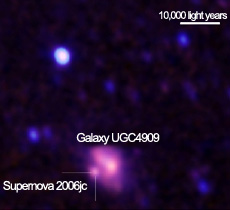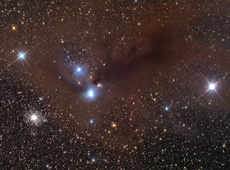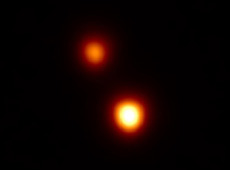

AKARI is observing not only the birth of stars, but also their death. The globular clusters NGC 104 and U Hydrae, it has captured stars in their final stages of life. A star with a mass similar to the sun expands as it ages, and becomes red as its surface temperature decreases. In the globular cluster NGC 104, we have detected strong emissions of dust from just such a red-giant star. It is believed that a star ejects large amount of gas and create dusts in the very late stage of its red-giant era. But, the star found by AKSTI in NGC 104 is still in relatively early stage of red giant. We need more observation to know the true nature of star's death. In order to speculate about the evolution of galaxies, it is very important to observe both newborn and dying stars. This allows us to observe how heavy elements and cosmic dust are dispersed into space. Heavy elements are produced by fusion reaction in stars, and cosmic dust is made from these elements.
AKARI has also spotted a supernova explosion, the final event of a massive star. Six months after the explosion, Supernova 2006jc, which took place in the galaxy UGC 4904, looked very dark in optical light. But in the infrared image taken by AKARI, it appears luminous. This confirms that strong infrared radiation was emitted from the supernova. Both AKARI and the Subaru Telescope observed that even before the supernova, the massive star, which was about 40 times heavier than the Sun, was ejecting gas which was producing dust. After the supernova, a significant amount of dust was produced from the gas emitted during the event itself. These are remarkable observations, which help us understand the source of interstellar dust.
AKARI has also captured the first infrared image of a supernova remnant in the Small Magellanic Cloud (SMC) - a galaxy about 200,000 light years from our own. A supernova remnant is produced by gas ejected into interstellar space during a supernova. Hot gas in a supernova remnant can be observed in X-ray or radio waves. But to study the influence of a supernova on nearby cold interstellar matter, we must use infrared observation. AKARI's infrared observations have shown that gas is heated by shock waves that occur in gas clouds. Thanks to AKARI's high resolution, we have been able to obtain a lot of data on the interactions between supernova remnants and interstellar materials, which had been difficult to observe before.

Supernova 2006jc

Supernova remnant B0104-72.3 in the Small Magellanic Cloud (the white line indicates a distance of 30 light years)

To discover more about the evolution of galaxies, we need to observe what they used to be like and so we need to observe very distant galaxies. To do so, AKARI carried out the largest-scale infrared observation ever achieved, and has successfully produced images from many galaxies at great distances. We made our observations through something called the “galactic window”, a region in the Milky Way that makes such observations possible because it has the least interstellar matter. In the images AKARI captured, many galaxies appear as white dots. Galaxies have a wide range of brightness, and dark ones are thought to be galaxies in the distant reaches of the universe. The farthest galaxy may be over 10 billion light years away. AKARI gave us our first glimpse of many of these distant galaxies.
By studying an era of active star formation, we have discovered that more than six billion years ago there was period of prolific star formation that went on for billions of years. We have also found obscure infrared radiation in places where no galaxies exist. This light is called infrared cosmic background radiation, containing radiation from the era close to the beginning of the universe. By investigating the irregularity of brightness and the range of different wavelengths of this infrared cosmic background radiation, I expect that we'll be able to get a much better idea about the origin of galaxies and other space structures.

Q. How is AKARI evaluated in and outside Japan?
AKARI has been collecting a variety of new data. Thanks to the success of Japan's first infrared astronomical satellite, Japanese astronomers can study our own data, no longer depending on data produced overseas. This is a real boost for Japanese infrared astronomy. We will make more exciting discoveries as we continue to analyze the data. AKARI has also been very well received abroad, and foreign science magazines picked up on the all-sky map very quickly. We are collaborating with researchers in Europe, so their local newspapers and science museums have also reported on the AKARI mission.

Cosmic dust (dark nebulae) and stars seen in optical light (Courtesy of Adam Block, NOAO, AURA, NSF)

Brown dwarfs in a binary system situated in the constellation Chamaeleon (Courtesy of K. Luhman, Harvard-Smithsonian Center for Astrophysics)
Center for Astrophysics)
Q. Please tell us about future plans for AKARI research.
Research on cosmic dust using AKARI data is underway. Cosmic dust is made up of small solid particles that appear luminous in infrared light. Cosmic dust and interstellar gas occur together in outer space, and they are important components of Earth-type planets. However, the source of cosmic dust is still a mystery. How is dust produced at the final stage of a star's life? And what happens to dust while it drifts in interstellar space, or at the site of a planet's formation, or near a young star? I am really looking forward to AKARI data telling us the untold story of cosmic dust.
I'd also like to assess the distribution of dust in our solar system, which was made by comets or collisions between asteroids. Cosmic dust, which has continued to pour over the Earth, is not only an ingredient for planetary formation but may also be an ingredient for life on Earth. AKARI has been collecting a lot of data on dust in the solar system, so I think that its composition and distribution will be clarified someday.
I also expect a full explanation of planetary evolution. AKARI has observed gas clouds in the constellation Chamaeleon, at 520 light years from Earth, which will allow us to thoroughly survey active regions of star formation. Dust disks found around young stars glow in infrared, but the brightness diminishes as soon as dust begins clumping to form planets. It is possible to hypothesize how dust evolves into planets by watching the darkening progress closely.
Also, we will be able to determine the components and temperatures of space dust. For example, we can tell whether dust first starts gathering in the hot regions close to stars, or is spread out more evenly. Seeing these images in infrared is like reading the scenario of planetary formation. AKARI is capable of observing darker dust disks than ever seen before. The infrared eye of NASA's Spitzer Telescope has found gas and dust disks, which are ingredients for planets, around substellar brown dwarfs in Chamaeleon. I am very much looking forward to what we are going to find with AKARI.
We are also in the midst of studying the atmosphere of brown dwarfs. A brown dwarf is too small to ignite a fusion reaction like the Sun does. The temperature on the surface is about 3000°C at birth, but subsequently it begins to cool, and AKARI has detected some celestial bodies with low surface temperatures. Another feature of brown dwarfs- celestial bodies that are somewhere between a star and a planet - is methane in the atmosphere, as found in the atmospheres of planets. Currently, AKARI is the only source of data on the atmosphere of brown dwarfs. This data may become an asset for future comparative studies of extra-solar planets, once the necessary data becomes available.
